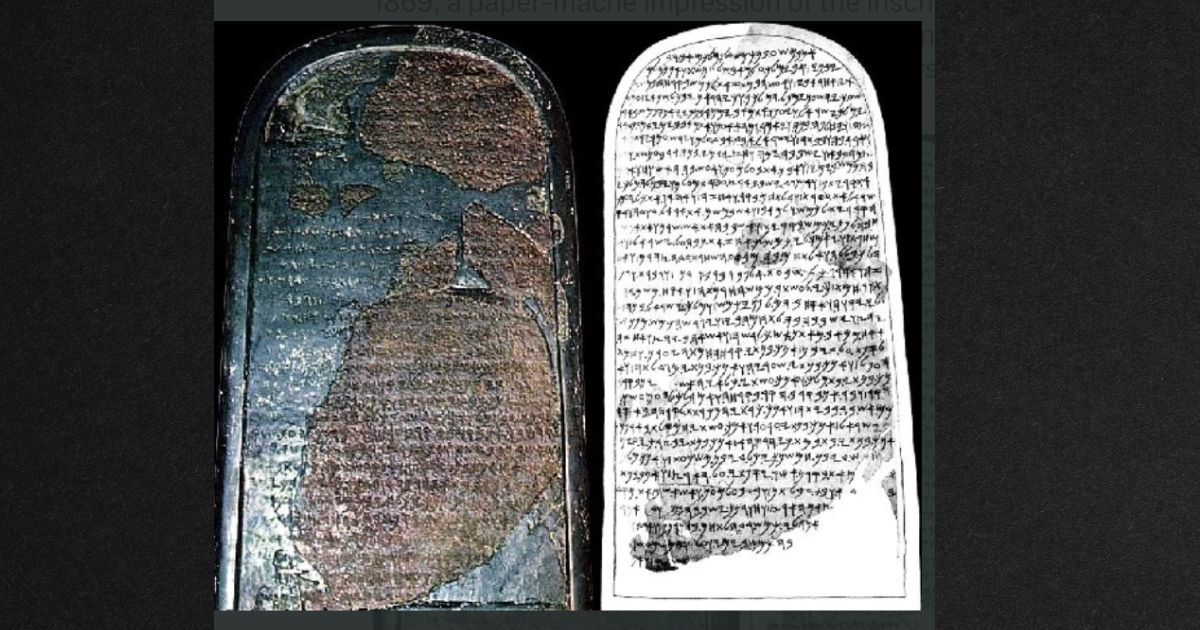New analysis of an ancient Levantine artifact may have revealed a reference to a key figure of the Old Testament of the Bible.
Two French scholars say they’ve identified a reference to the “House of David” on the Mesha Stele, a basalt rock with inscriptions that date back to the ninth century before Christ, according to the Jewish News Syndicate.
The reference could corroborate the biblical account of King David — the figure who founded ancient Israel’s most historic dynasty of kings.
Andre Lemaire and Jean-Philippe Delorme announced they had identified the reference to the House of David on the artifact using a technology called Reflectance Transformation Imaging.
“Reflectance Transformation Imaging (RTI) is a photographic method that captures a subject’s shape and colour to reveal surface information invisible under normal examination,” according to Wessex Archaeology.
“Images are created from multiple photographs of a subject, where each shot is taken with light projected from a different direction to produce varying highlights and shadows. These are then combined so the changing interplay of light and dark discloses fine details of the surface.”
159. Biblical People in Inscriptions
Before the Mesha Stele (840 BC) was damaged in 1869, a paper-mache impression of the inscription was made. Using Reflectance Transformation Imaging, analysis found traces of three letters on line 31, confirming btdwd “house of David.” pic.twitter.com/nWo6ZRJ43U
— DailyEvidence (@dailyevidence) January 20, 2023
The ancient basalt stone is displayed at the Louvre museum in Paris, France.
The Moabite Stone, otherwise known as the Mesha Stele, contains an ancient inscription by Mesha, King of Moab during the late 9th century BCE, elements of which match events in the Hebrew Bible. https://t.co/UHvneFlq0h pic.twitter.com/NTq0QiCtSt
— World History Encyclopedia (@whencyclopedia) September 10, 2021
David is a key figure in Christianity and Judaism, and Christians view Jesus as his direct descendant — a fulfillment of Old Testament prophecy.
Biblical scholars generally view King David as having lived around 1000 BC, according to Britannica.
“These insights … not only confirm that the Mesha Stele references the ‘House of David’ but also allow us to draw new conclusions about the various historical and biblical events described in the text,” the historians said of their translation in the Biblical Archaeological Review in January, according to JNS.
The potential reference to the legendary Israelite king doesn’t come from a Jewish primary source.
The artifact in question is written in a Caananite language, describing the victories of King Mesha of Moab — an adversary of Israel mentioned in the Bible.
The Caananites appear as frequent enemies of the Israelites throughout the Old Testament, struggling with the ancient Hebrews over the modern-day Holy Land for centuries.
The Kingdom of Moab was a Caananite kingdom located in modern-day Jordan.
The Mesha Stele, also known as the “Moabite Stone,” was recovered in Dhiban, Jordan, in 1868.
The stone was broken into several pieces shortly after its discovery, which has long delayed its definitive translation, according to JNS.
Delmore and Lemaire’s claims of a reference to King David on the artifact do have their critics.
An earlier study of the stone, co-authored by Israeli professor Israel Finkelstein, asserts the line in question refers to a different Moabite King, Balak, who also appears in the Bible.
Finkelstein told JNS he stands by his 2019 translation of the stone.
This article appeared originally on The Western Journal.

























 Continue with Google
Continue with Google